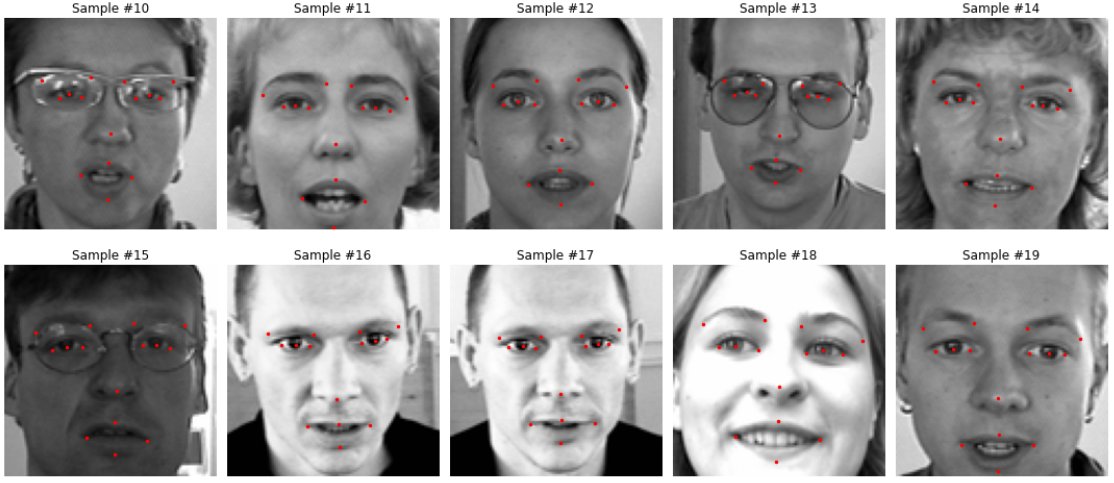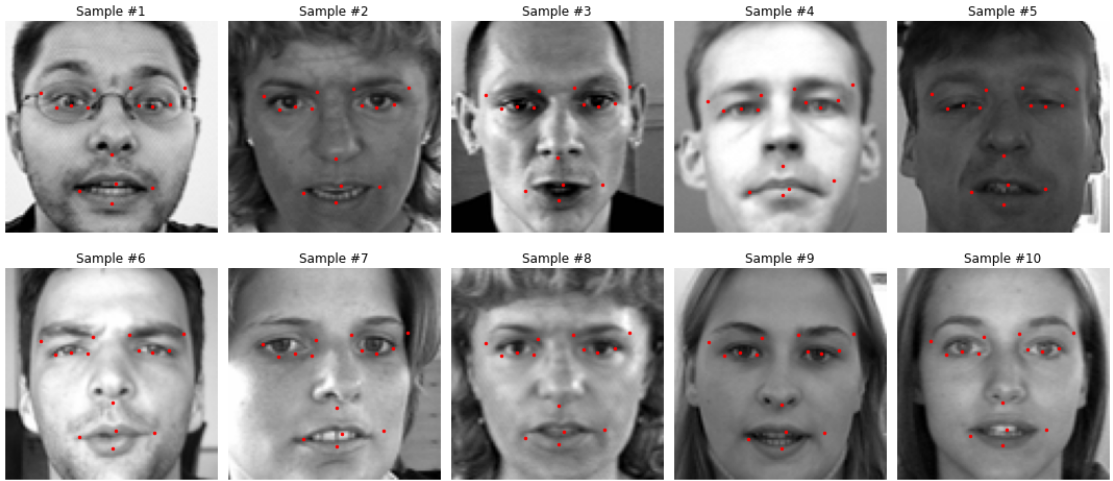Facial Keypoints Detection
Time: 2022.11.11
Author: Shaw
一、任务简介:
- 任务:正确标注所给图片的人脸关键位置;
- 关键位置(keypoint):
| 字段 | 解释 |
|---|---|
| left_eye_center | 左眼中心 |
| right_eye_center | 右眼中心 |
| left_eye_inner_corner | 左眼内眼角 |
| left_eye_outer_corner | 左眼外眼角 |
| right_eye_inner_corner | 右眼内眼角 |
| right_eye_outer_corner | 右眼外眼角 |
| left_eyebrow_inner_end | 左眉内侧 |
| left_eyebrow_outer_end | 左眉外侧 |
| right_eyebrow_inner_end | 右眉内侧 |
| right_eyebrow_outer_end | 右眉外侧 |
| nose_tip | 鼻尖 |
| mouth_left_corner | 嘴左角 |
| mouth_right_corner | 嘴右角 |
| mouth_center_top_lip | 上唇中心 |
| mouth_center_bottom_lip | 下唇中心 |
数据组成:
- training.csv: 包含7049张训练图片,每张图片有15个keypoint坐标(每个坐标用x,y两列数据表示,有些数值缺失),图像数据作为按行排序的像素列表。故表格中的数据标签有30列,图片数据一列共31列;
- test.csv: 包含1783张测试图片;
- ubmissionFileFormat.csv: 待提交的测试结果。
样例:

二、数据分析处理
首先加载训练数据与测试数据:
#Load the data
train_data = pd.read_csv(TRAIN_PATH)
test_data = pd.read_csv(TEST_PATH)
print(train_data.columns)
print(test_data.columns)2.1 空值填补
因为数据中存在缺失值,故统计分析存在缺失值的列:
train_data.isnull().any().value_counts()
#out:
'''
True 28
False 3
dtype: int64
'''故28个属性列都存在缺失值,接下来填补缺失,‘ffill’方法表示用前面一列的值填补当前位置的值:
train_data.fillna(method = 'ffill',inplace = True)同时,Image列中的部分数值由‘ ’空格替代,这里将其替换为0:
train_data['Image_new'] = train_data['Image'].map(lambda x:['0' if i == ' ' else i for i in x.split(' ')])
image_list = np.array(train_data['Image_new'].to_list(),dtype='float')2.2 相关图片处理函数编写
IMG_SIZE = 96 # image size 96 x 96 pixels
def show_keypoints(image, keypoints):
'''
Show image with keypoints
Args:
image (array-like or PIL image): The image data. (M, N)
keypoints (array-like): The keypoits data. (N, 2)
'''
plt.imshow(image, cmap='gray')
if len(keypoints):
plt.scatter(keypoints[:, 0], keypoints[:, 1], s=24, marker='.', c='r')
def show_images(df, indxs, ncols=5, figsize=(15,10), with_keypoints=True):
'''
Show images with keypoints in grids
Args:
df (DataFrame): data (M x N)
idxs (iterators): list, Range, Indexes
ncols (integer): number of columns (images by rows)
figsize (float, float): width, height in inches
with_keypoints (boolean): True if show image with keypoints
'''
plt.figure(figsize=figsize)
nrows = len(indxs) // ncols + 1
for i, idx in enumerate(indxs):
image = np.fromstring(df.loc[idx, 'Image'], sep=' ').astype(np.float32)\
.reshape(-1, IMG_SIZE)
if with_keypoints:
keypoints = df.loc[idx].drop('Image').values.astype(np.float32)\
.reshape(-1, 2)
else:
keypoints = []
plt.subplot(nrows, ncols, i + 1)
plt.title(f'Sample #{idx}')
plt.axis('off') #关闭坐标轴
plt.tight_layout() # tight_layout会自动调整子图参数,使之填充整个图像区域
show_keypoints(image, keypoints)
plt.show()2.3 分割数据集
使用Dataset和DataLoader相关pytorch类来加载数据集。
定义数据集子类用于自动处理dataframe数据,返回{‘image’: image, ‘keypoints’: keypoints}类型的数据:
class FaceKeypointsDataset(Dataset):
'''Face Keypoints Dataset'''
def __init__(self, dataframe, train=True, transform=None):
'''
Args:
dataframe (DataFrame): data in pandas dataframe format.
train (Boolean) : True for train data with keypoints, default is True
transform (callable, optional): Optional transform to be applied on
sample
'''
self.dataframe = dataframe
self.train = train
self.transform = transform
def __len__(self):
return len(self.dataframe)
def __getitem__(self, idx):
image = np.fromstring(self.dataframe.iloc[idx, -1], sep=' ')\
.astype(np.float32).reshape(-1, IMG_SIZE)
if self.train:
keypoints = self.dataframe.iloc[idx, :-1].values.astype(np.float32)
else:
keypoints = None
sample = {'image': image, 'keypoints': keypoints}
if self.transform:
sample = self.transform(sample)
return sample将数据正则化,转化为tensor:
class Normalize(object):
'''Normalize input images'''
def __call__(self, sample):
image, keypoints = sample['image'], sample['keypoints']
return {'image': image / 255., # scale to [0, 1]
'keypoints': keypoints}
class ToTensor(object):
'''Convert ndarrays in sample to Tensors.'''
def __call__(self, sample):
image, keypoints = sample['image'], sample['keypoints']
# swap color axis because
# numpy image: H x W x C
# torch image: C X H X W
image = image.reshape(1, IMG_SIZE, IMG_SIZE)
image = torch.from_numpy(image)
if keypoints is not None:
keypoints = torch.from_numpy(keypoints)
return {'image': image, 'keypoints': keypoints}
else:
return {'image': image}利用SubsetRandomSampler构建采样器,并使用Dataloader构建数据加载器:
from torch.utils.data.sampler import SubsetRandomSampler
def prepare_train_valid_loaders(trainset,valid_size = 0.2,batch_size = 128):
# obtain training indices that will be used for validation
# 这里保障了训练集和测试集的随机划分
num_train = len(trainset)
indices = list(range(num_train))
np.random.shuffle(indices)
split = int(np.floot(valid_size*num_train))
train_idx, valid_idx = indices[split:], indices[:split]
# define samplers for obtaining training and validation batches
# 这里保障了一轮epoch中每次生成的batch是随机的,避免模型学习到数据的顺序特征
train_sampler = SubsetRandomSampler(train_idx)
valid_sampler = SubsetRandomSampler(valid_idx)
# prepare data loaders
train_loader = torch.utils.data.DataLoader(trainset, batch_size=batch_size,
sampler=train_sampler)
valid_loader = torch.utils.data.DataLoader(trainset, batch_size=batch_size,
sampler=valid_sampler)
return train_loader, valid_loader正式加载数据:
from torchvision import transforms
# how many samples per batch to load
batch_size = 128
# percentage of training set to use as validation
valid_size = 0.2
# Define a transform to normalize the data
tsfm = transforms.Compose([Normalize(), ToTensor()])
# Load the training data and test data
trainset = FaceKeypointsDataset(train_data, transform=tsfm)
testset = FaceKeypointsDataset(test_data, train=False, transform=tsfm)
# prepare data loaders
train_loader, valid_loader = prepare_train_valid_loaders(trainset,
valid_size,
batch_size)
test_loader = torch.utils.data.DataLoader(testset, batch_size=batch_size)三、模型搭建
#Model
class CNN(nn.Module):
def __init__(self,outputs = 30):
super(CNN,self).__init__()
self.conv1 = nn.Conv2d(1, 16, 3, padding=1)
self.conv2 = nn.Conv2d(16, 32, 3, padding=1)
self.conv3 = nn.Conv2d(32, 64, 3, padding=1)
self.pool = nn.MaxPool2d(2, 2)
self.fc1 = nn.Linear(64*12*12, 1024)
self.fc2 = nn.Linear(1024, outputs)
self.dropout = nn.Dropout(0.3)
def forward(self,x):
x = self.pool(F.relu(self.conv1(x)))
x = self.pool(F.relu(self.conv2(x)))
x = self.pool(F.relu(self.conv3(x)))
x = x.view(-1, 64*12*12)
x = F.relu(self.fc1(self.dropout(x)))
x = self.fc2(self.dropout(x))
return x四、训练与测试
#Train & Validate
device = torch.device('cuda' if torch.cuda.is_available() else 'cpu')
model = CNN(outputs = 30)
model = model.to(device)
criterion = nn.MSELoss()
optimizer = optim.Adam(model.parameters(), lr=0.003)
def train(train_loader,valid_loader,model,criterion,optimizer,n_epochs = 50,saved_model = 'cv_model.pt'):
valid_loss_min = np.Inf
train_losses = []
valid_losses = []
for epoch in range(n_epochs):
train_loss = 0.0
valid_loss = 0.0
#training
model.train()
for batch in train_loader:
optimizer.zero_grad()
output = model(batch['image'].to(device))
loss = criterion(output,batch['keypoints'].to(device))
loss.backward()
optimizer.step()
train_loss += loss.item()*batch['image'].size(0)
#validating
model.eval()
for batch in valid_loader:
output = model(batch['image'].to(device))
loss = criterion(output, batch['keypoints'].to(device))
valid_loss += loss.item()*batch['image'].size(0)
train_loss = np.sqrt(train_loss/len(train_loader.sampler.indices))
valid_loss = np.sqrt(valid_loss/len(valid_loader.sampler.indices))
train_losses.append(train_loss)
valid_losses.append(valid_loss)
print('Epoch: {} \tTraining Loss: {:.6f} \tValidation Loss: {:.6f}'
.format(epoch+1, train_loss, valid_loss))
# save model if validation loss has decreased
if valid_loss <= valid_loss_min:
print('Validation loss decreased ({:.6f} --> {:.6f}). Saving model ...'
.format(valid_loss_min, valid_loss))
torch.save(model.state_dict(), saved_model)
valid_loss_min = valid_loss
return train_losses, valid_losses定义测试函数:
def predict(data_loader, model):
'''
Predict keypoints
Args:
data_loader (DataLoader): DataLoader for Dataset
model (nn.Module): trained model for prediction.
Return:
predictions (array-like): keypoints in float (no. of images x keypoints).
'''
model.eval() # prep model for evaluation
with torch.no_grad():
for i, batch in enumerate(data_loader):
# forward pass: compute predicted outputs by passing inputs to the model
output = model(batch['image'].to(device)).cpu().numpy()
if i == 0:
predictions = output
else:
predictions = np.vstack((predictions, output))
return predictions定义测试结果展示函数:
def view_pred_df(columns, test_df, predictions, image_ids=range(1,6)):
'''
Display predicted keypoints
Args:
columns (array-like): column names
test_df (DataFrame): dataframe with ImageId and Image columns
predictions (array-like): keypoints in float (no. of images x keypoints)
image_id (array-like): list or range of ImageIds begin at 1
'''
pred_df = pd.DataFrame(predictions, columns=columns)
pred_df = pd.concat([pred_df, test_df], axis=1)
pred_df = pred_df.set_index('ImageId')
show_images(pred_df, image_ids) # ImageId as index begin at 1定义测试结果上交文件生成函数:
def create_submission(predictions, pred_file='data/preds.csv', sub_file='data/submission.csv', columns=None):
'''
Create csv file for submission from predictions
Args:
predictions (array-like): prediction (no. fo images x 30 keypoints)
pred_file (string): file path for prediction csv file
sub_file (string): file path for submission csv file
columns (dict): provided column names for submission file
'''
lookup = pd.read_csv('data/IdLookupTable.csv')
if columns == None:
columns = train_data.columns[:-1]
preds = pd.DataFrame(predictions,
index=np.arange(1, len(predictions)+1),
columns=columns)
preds.to_csv(pred_file)
locations = [preds.loc[image_id, feature_name]
for image_id, feature_name
in lookup[['ImageId', 'FeatureName']].values]
locations = [location if location <
IMG_SIZE else IMG_SIZE for location in locations]
lookup.Location = pd.Series(locations)
lookup[['RowId', 'Location']].to_csv(sub_file, index=False)训练 and 预测:
#Train & Validate
train(train_loader, valid_loader, model, criterion, optimizer, n_epochs=50, saved_model='aug_cnn.pt')
#Predict
model.load_state_dict(torch.load('aug_cnn.pt'))
predictions = predict(test_loader,model)
create_submission(predictions,
pred_file='data/aug_cnn_preds.csv',
sub_file='data/aug_cnn_submission.csv')
columns = train_data.drop('Image', axis=1).columns
view_pred_df(columns, test_data, predictions,range(1,11))预测结果:

将submission文件上交到Kaggle评分:

